Analysis of IT Systems for ENGEO Ltd: Data and Knowledge Management
VerifiedAdded on 2020/06/05
|10
|3312
|95
Report
AI Summary
This report analyzes the IT systems of ENGEO Ltd, focusing on data management, knowledge management, and communication. It explores the company's manual processes and proposes a cloud-based model for improved efficiency and data security. The report discusses various IT systems for data storage and processing, including database management systems and big data tools like Hadoop. It also highlights the role of IT in customer relationship management (CRM) and supporting value-added changes for business operations, performance, and sustainability. The report covers data management techniques such as data warehouses and big data solutions, as well as different information systems like MIS and DSS. The report concludes with a discussion on how IT systems can solve common business problems and improve overall organizational performance.
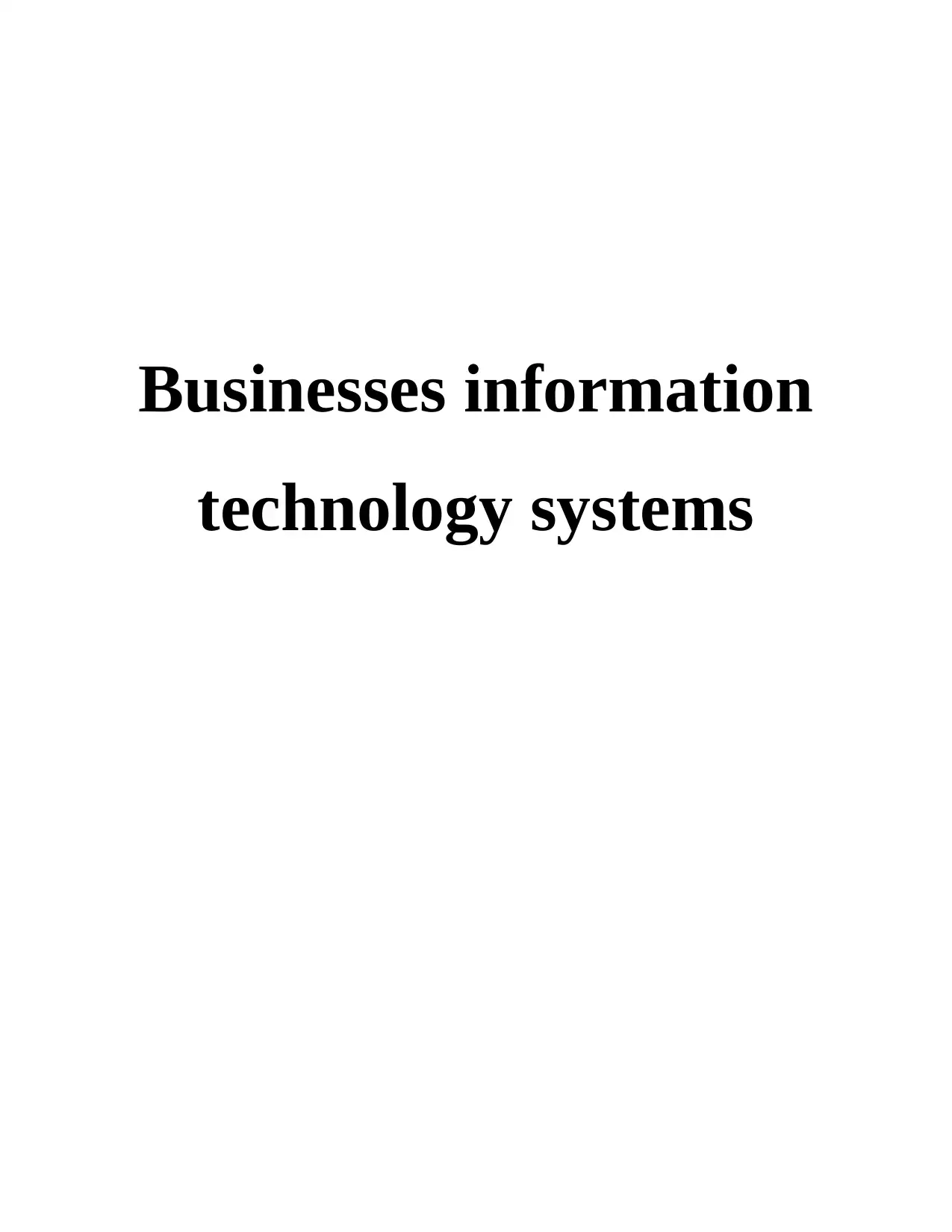
Businesses information
technology systems
technology systems
Paraphrase This Document
Need a fresh take? Get an instant paraphrase of this document with our AI Paraphraser
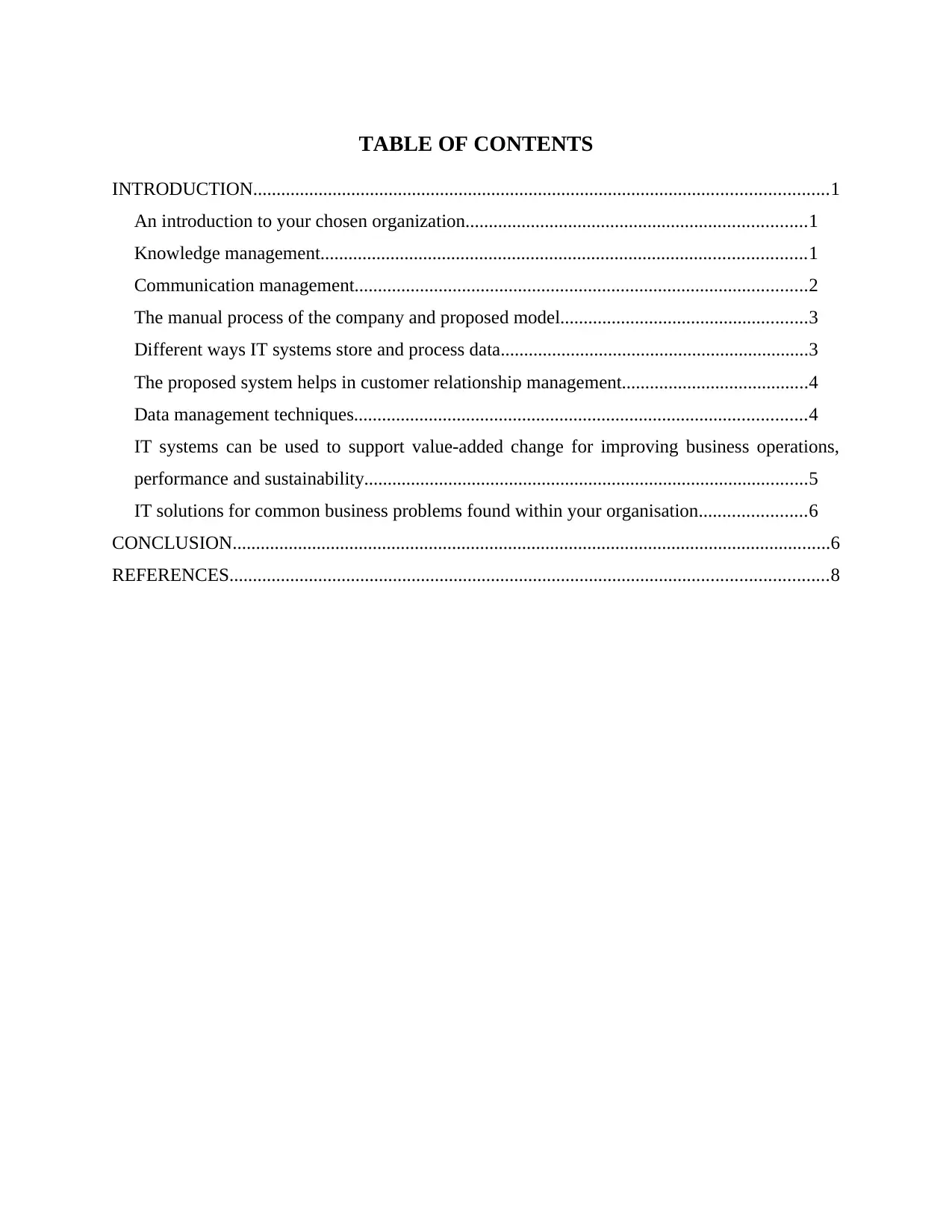
TABLE OF CONTENTS
INTRODUCTION...........................................................................................................................1
An introduction to your chosen organization.........................................................................1
Knowledge management........................................................................................................1
Communication management.................................................................................................2
The manual process of the company and proposed model.....................................................3
Different ways IT systems store and process data..................................................................3
The proposed system helps in customer relationship management........................................4
Data management techniques.................................................................................................4
IT systems can be used to support value-added change for improving business operations,
performance and sustainability...............................................................................................5
IT solutions for common business problems found within your organisation.......................6
CONCLUSION................................................................................................................................6
REFERENCES................................................................................................................................8
INTRODUCTION...........................................................................................................................1
An introduction to your chosen organization.........................................................................1
Knowledge management........................................................................................................1
Communication management.................................................................................................2
The manual process of the company and proposed model.....................................................3
Different ways IT systems store and process data..................................................................3
The proposed system helps in customer relationship management........................................4
Data management techniques.................................................................................................4
IT systems can be used to support value-added change for improving business operations,
performance and sustainability...............................................................................................5
IT solutions for common business problems found within your organisation.......................6
CONCLUSION................................................................................................................................6
REFERENCES................................................................................................................................8
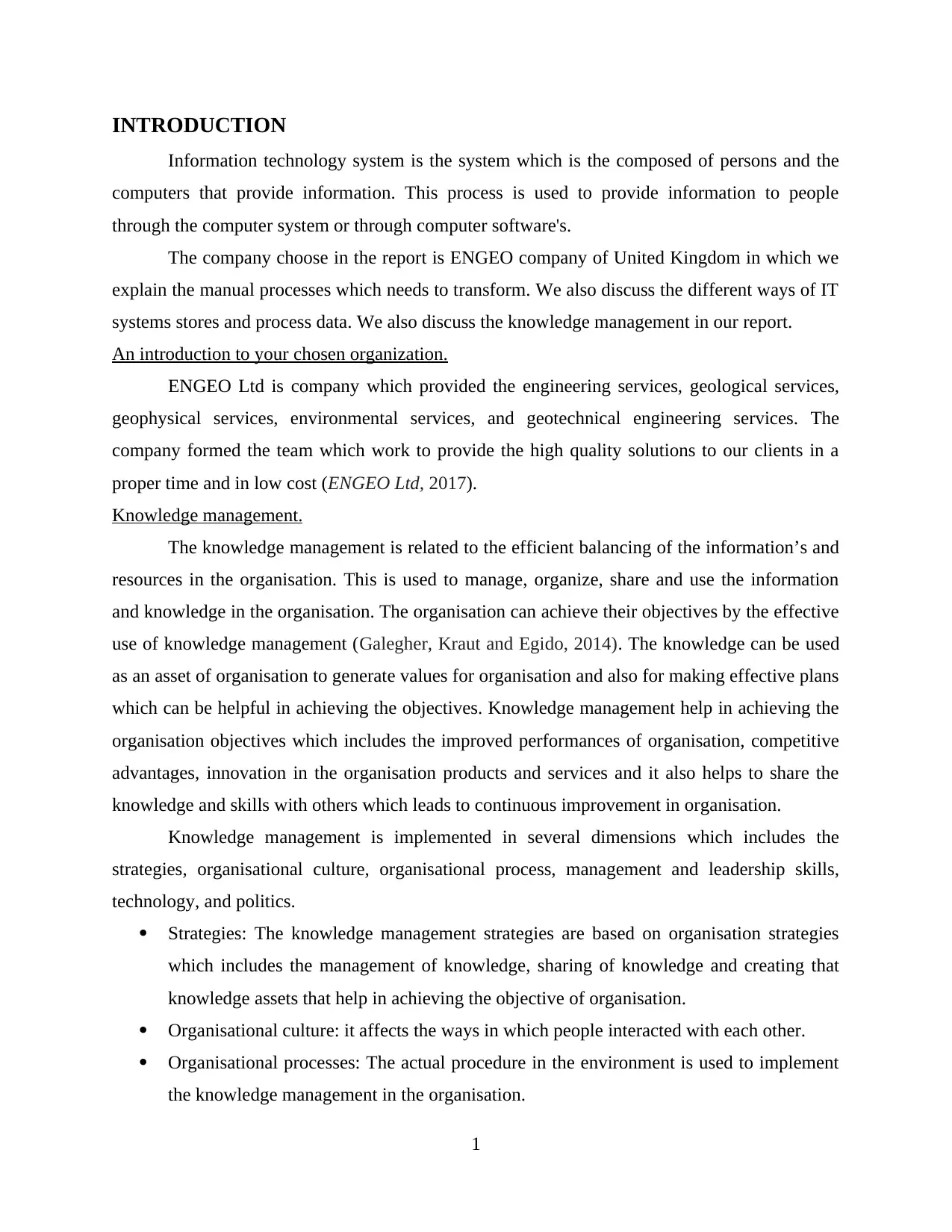
INTRODUCTION
Information technology system is the system which is the composed of persons and the
computers that provide information. This process is used to provide information to people
through the computer system or through computer software's.
The company choose in the report is ENGEO company of United Kingdom in which we
explain the manual processes which needs to transform. We also discuss the different ways of IT
systems stores and process data. We also discuss the knowledge management in our report.
An introduction to your chosen organization.
ENGEO Ltd is company which provided the engineering services, geological services,
geophysical services, environmental services, and geotechnical engineering services. The
company formed the team which work to provide the high quality solutions to our clients in a
proper time and in low cost (ENGEO Ltd, 2017).
Knowledge management.
The knowledge management is related to the efficient balancing of the information’s and
resources in the organisation. This is used to manage, organize, share and use the information
and knowledge in the organisation. The organisation can achieve their objectives by the effective
use of knowledge management (Galegher, Kraut and Egido, 2014). The knowledge can be used
as an asset of organisation to generate values for organisation and also for making effective plans
which can be helpful in achieving the objectives. Knowledge management help in achieving the
organisation objectives which includes the improved performances of organisation, competitive
advantages, innovation in the organisation products and services and it also helps to share the
knowledge and skills with others which leads to continuous improvement in organisation.
Knowledge management is implemented in several dimensions which includes the
strategies, organisational culture, organisational process, management and leadership skills,
technology, and politics.
Strategies: The knowledge management strategies are based on organisation strategies
which includes the management of knowledge, sharing of knowledge and creating that
knowledge assets that help in achieving the objective of organisation.
Organisational culture: it affects the ways in which people interacted with each other.
Organisational processes: The actual procedure in the environment is used to implement
the knowledge management in the organisation.
1
Information technology system is the system which is the composed of persons and the
computers that provide information. This process is used to provide information to people
through the computer system or through computer software's.
The company choose in the report is ENGEO company of United Kingdom in which we
explain the manual processes which needs to transform. We also discuss the different ways of IT
systems stores and process data. We also discuss the knowledge management in our report.
An introduction to your chosen organization.
ENGEO Ltd is company which provided the engineering services, geological services,
geophysical services, environmental services, and geotechnical engineering services. The
company formed the team which work to provide the high quality solutions to our clients in a
proper time and in low cost (ENGEO Ltd, 2017).
Knowledge management.
The knowledge management is related to the efficient balancing of the information’s and
resources in the organisation. This is used to manage, organize, share and use the information
and knowledge in the organisation. The organisation can achieve their objectives by the effective
use of knowledge management (Galegher, Kraut and Egido, 2014). The knowledge can be used
as an asset of organisation to generate values for organisation and also for making effective plans
which can be helpful in achieving the objectives. Knowledge management help in achieving the
organisation objectives which includes the improved performances of organisation, competitive
advantages, innovation in the organisation products and services and it also helps to share the
knowledge and skills with others which leads to continuous improvement in organisation.
Knowledge management is implemented in several dimensions which includes the
strategies, organisational culture, organisational process, management and leadership skills,
technology, and politics.
Strategies: The knowledge management strategies are based on organisation strategies
which includes the management of knowledge, sharing of knowledge and creating that
knowledge assets that help in achieving the objective of organisation.
Organisational culture: it affects the ways in which people interacted with each other.
Organisational processes: The actual procedure in the environment is used to implement
the knowledge management in the organisation.
1
⊘ This is a preview!⊘
Do you want full access?
Subscribe today to unlock all pages.

Trusted by 1+ million students worldwide
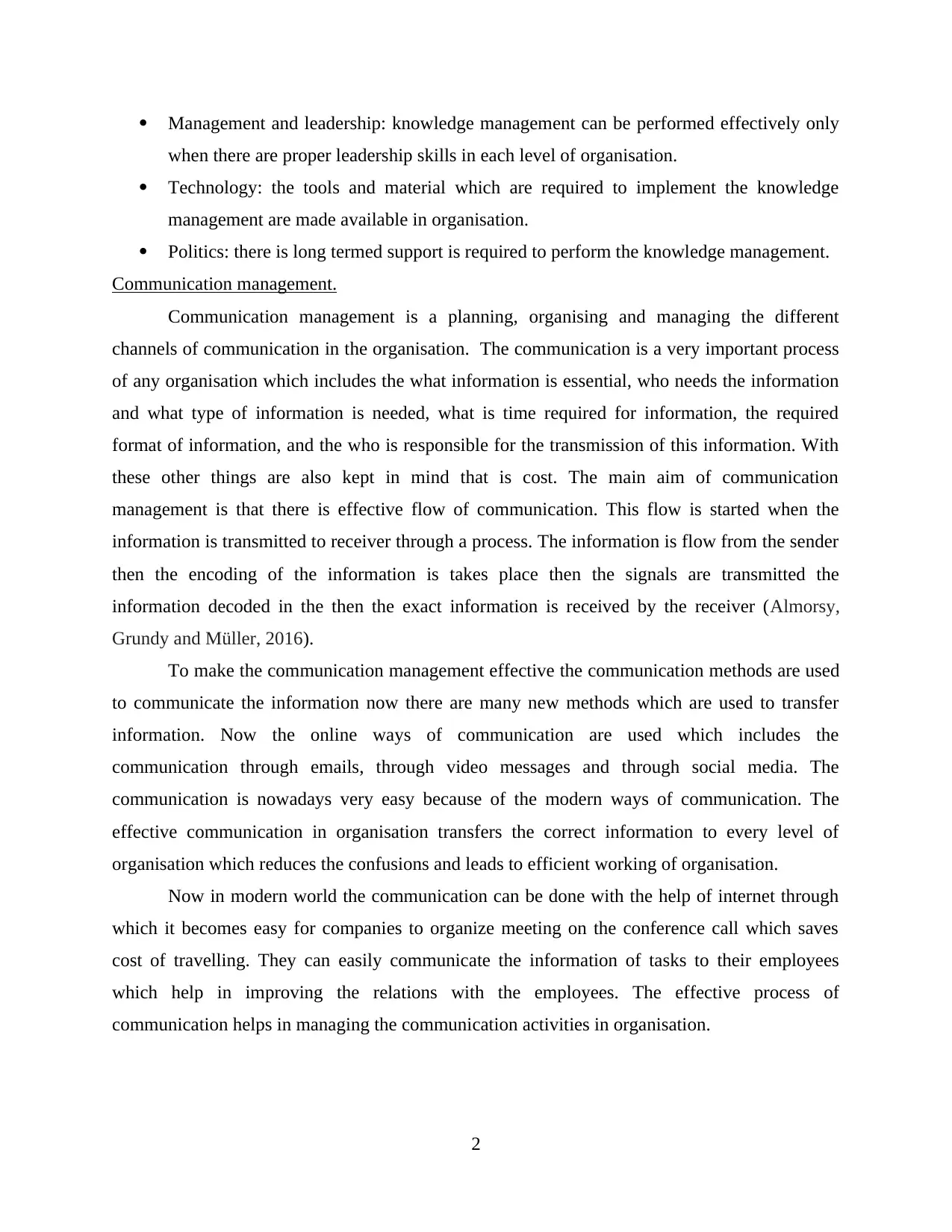
Management and leadership: knowledge management can be performed effectively only
when there are proper leadership skills in each level of organisation.
Technology: the tools and material which are required to implement the knowledge
management are made available in organisation.
Politics: there is long termed support is required to perform the knowledge management.
Communication management.
Communication management is a planning, organising and managing the different
channels of communication in the organisation. The communication is a very important process
of any organisation which includes the what information is essential, who needs the information
and what type of information is needed, what is time required for information, the required
format of information, and the who is responsible for the transmission of this information. With
these other things are also kept in mind that is cost. The main aim of communication
management is that there is effective flow of communication. This flow is started when the
information is transmitted to receiver through a process. The information is flow from the sender
then the encoding of the information is takes place then the signals are transmitted the
information decoded in the then the exact information is received by the receiver (Almorsy,
Grundy and Müller, 2016).
To make the communication management effective the communication methods are used
to communicate the information now there are many new methods which are used to transfer
information. Now the online ways of communication are used which includes the
communication through emails, through video messages and through social media. The
communication is nowadays very easy because of the modern ways of communication. The
effective communication in organisation transfers the correct information to every level of
organisation which reduces the confusions and leads to efficient working of organisation.
Now in modern world the communication can be done with the help of internet through
which it becomes easy for companies to organize meeting on the conference call which saves
cost of travelling. They can easily communicate the information of tasks to their employees
which help in improving the relations with the employees. The effective process of
communication helps in managing the communication activities in organisation.
2
when there are proper leadership skills in each level of organisation.
Technology: the tools and material which are required to implement the knowledge
management are made available in organisation.
Politics: there is long termed support is required to perform the knowledge management.
Communication management.
Communication management is a planning, organising and managing the different
channels of communication in the organisation. The communication is a very important process
of any organisation which includes the what information is essential, who needs the information
and what type of information is needed, what is time required for information, the required
format of information, and the who is responsible for the transmission of this information. With
these other things are also kept in mind that is cost. The main aim of communication
management is that there is effective flow of communication. This flow is started when the
information is transmitted to receiver through a process. The information is flow from the sender
then the encoding of the information is takes place then the signals are transmitted the
information decoded in the then the exact information is received by the receiver (Almorsy,
Grundy and Müller, 2016).
To make the communication management effective the communication methods are used
to communicate the information now there are many new methods which are used to transfer
information. Now the online ways of communication are used which includes the
communication through emails, through video messages and through social media. The
communication is nowadays very easy because of the modern ways of communication. The
effective communication in organisation transfers the correct information to every level of
organisation which reduces the confusions and leads to efficient working of organisation.
Now in modern world the communication can be done with the help of internet through
which it becomes easy for companies to organize meeting on the conference call which saves
cost of travelling. They can easily communicate the information of tasks to their employees
which help in improving the relations with the employees. The effective process of
communication helps in managing the communication activities in organisation.
2
Paraphrase This Document
Need a fresh take? Get an instant paraphrase of this document with our AI Paraphraser
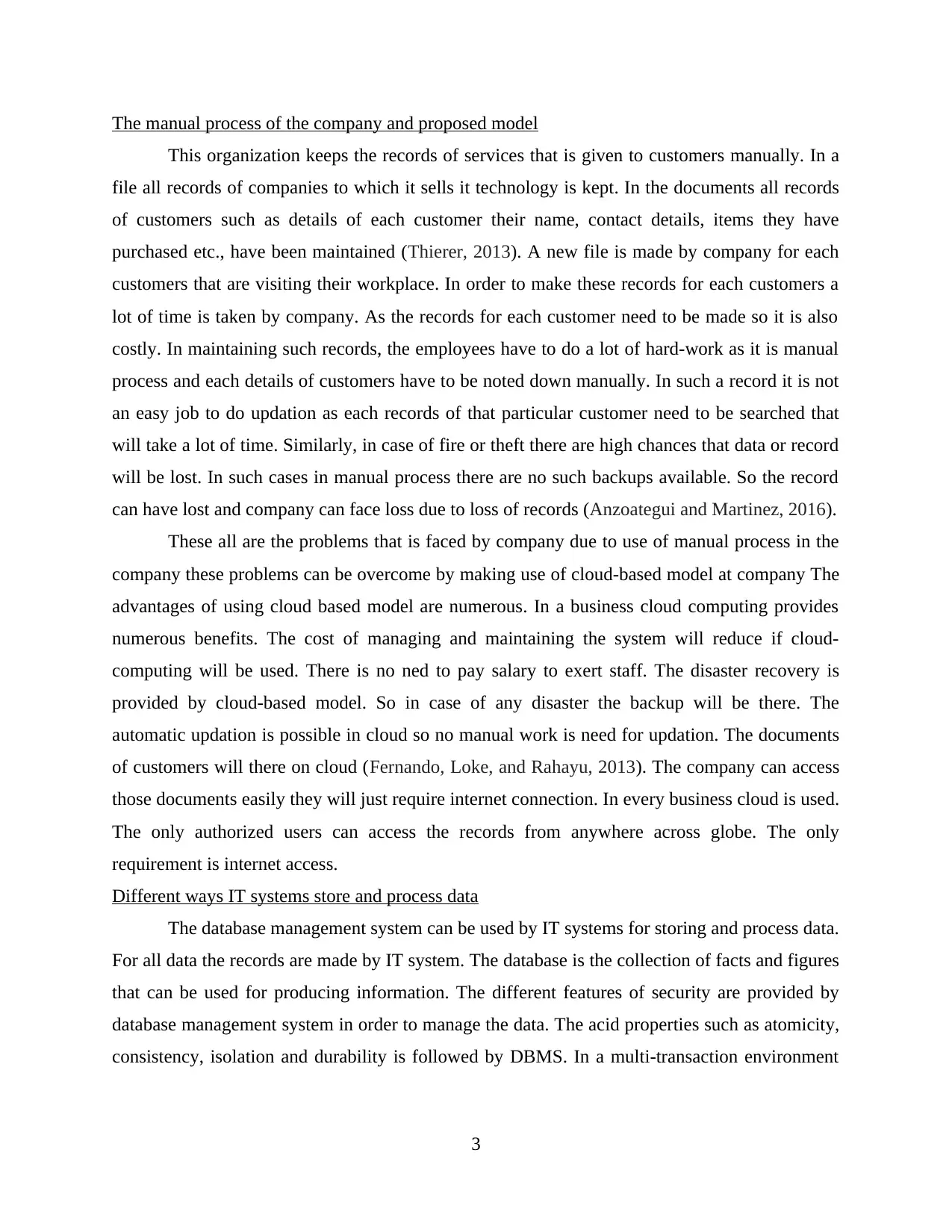
The manual process of the company and proposed model
This organization keeps the records of services that is given to customers manually. In a
file all records of companies to which it sells it technology is kept. In the documents all records
of customers such as details of each customer their name, contact details, items they have
purchased etc., have been maintained (Thierer, 2013). A new file is made by company for each
customers that are visiting their workplace. In order to make these records for each customers a
lot of time is taken by company. As the records for each customer need to be made so it is also
costly. In maintaining such records, the employees have to do a lot of hard-work as it is manual
process and each details of customers have to be noted down manually. In such a record it is not
an easy job to do updation as each records of that particular customer need to be searched that
will take a lot of time. Similarly, in case of fire or theft there are high chances that data or record
will be lost. In such cases in manual process there are no such backups available. So the record
can have lost and company can face loss due to loss of records (Anzoategui and Martinez, 2016).
These all are the problems that is faced by company due to use of manual process in the
company these problems can be overcome by making use of cloud-based model at company The
advantages of using cloud based model are numerous. In a business cloud computing provides
numerous benefits. The cost of managing and maintaining the system will reduce if cloud-
computing will be used. There is no ned to pay salary to exert staff. The disaster recovery is
provided by cloud-based model. So in case of any disaster the backup will be there. The
automatic updation is possible in cloud so no manual work is need for updation. The documents
of customers will there on cloud (Fernando, Loke, and Rahayu, 2013). The company can access
those documents easily they will just require internet connection. In every business cloud is used.
The only authorized users can access the records from anywhere across globe. The only
requirement is internet access.
Different ways IT systems store and process data
The database management system can be used by IT systems for storing and process data.
For all data the records are made by IT system. The database is the collection of facts and figures
that can be used for producing information. The different features of security are provided by
database management system in order to manage the data. The acid properties such as atomicity,
consistency, isolation and durability is followed by DBMS. In a multi-transaction environment
3
This organization keeps the records of services that is given to customers manually. In a
file all records of companies to which it sells it technology is kept. In the documents all records
of customers such as details of each customer their name, contact details, items they have
purchased etc., have been maintained (Thierer, 2013). A new file is made by company for each
customers that are visiting their workplace. In order to make these records for each customers a
lot of time is taken by company. As the records for each customer need to be made so it is also
costly. In maintaining such records, the employees have to do a lot of hard-work as it is manual
process and each details of customers have to be noted down manually. In such a record it is not
an easy job to do updation as each records of that particular customer need to be searched that
will take a lot of time. Similarly, in case of fire or theft there are high chances that data or record
will be lost. In such cases in manual process there are no such backups available. So the record
can have lost and company can face loss due to loss of records (Anzoategui and Martinez, 2016).
These all are the problems that is faced by company due to use of manual process in the
company these problems can be overcome by making use of cloud-based model at company The
advantages of using cloud based model are numerous. In a business cloud computing provides
numerous benefits. The cost of managing and maintaining the system will reduce if cloud-
computing will be used. There is no ned to pay salary to exert staff. The disaster recovery is
provided by cloud-based model. So in case of any disaster the backup will be there. The
automatic updation is possible in cloud so no manual work is need for updation. The documents
of customers will there on cloud (Fernando, Loke, and Rahayu, 2013). The company can access
those documents easily they will just require internet connection. In every business cloud is used.
The only authorized users can access the records from anywhere across globe. The only
requirement is internet access.
Different ways IT systems store and process data
The database management system can be used by IT systems for storing and process data.
For all data the records are made by IT system. The database is the collection of facts and figures
that can be used for producing information. The different features of security are provided by
database management system in order to manage the data. The acid properties such as atomicity,
consistency, isolation and durability is followed by DBMS. In a multi-transaction environment
3
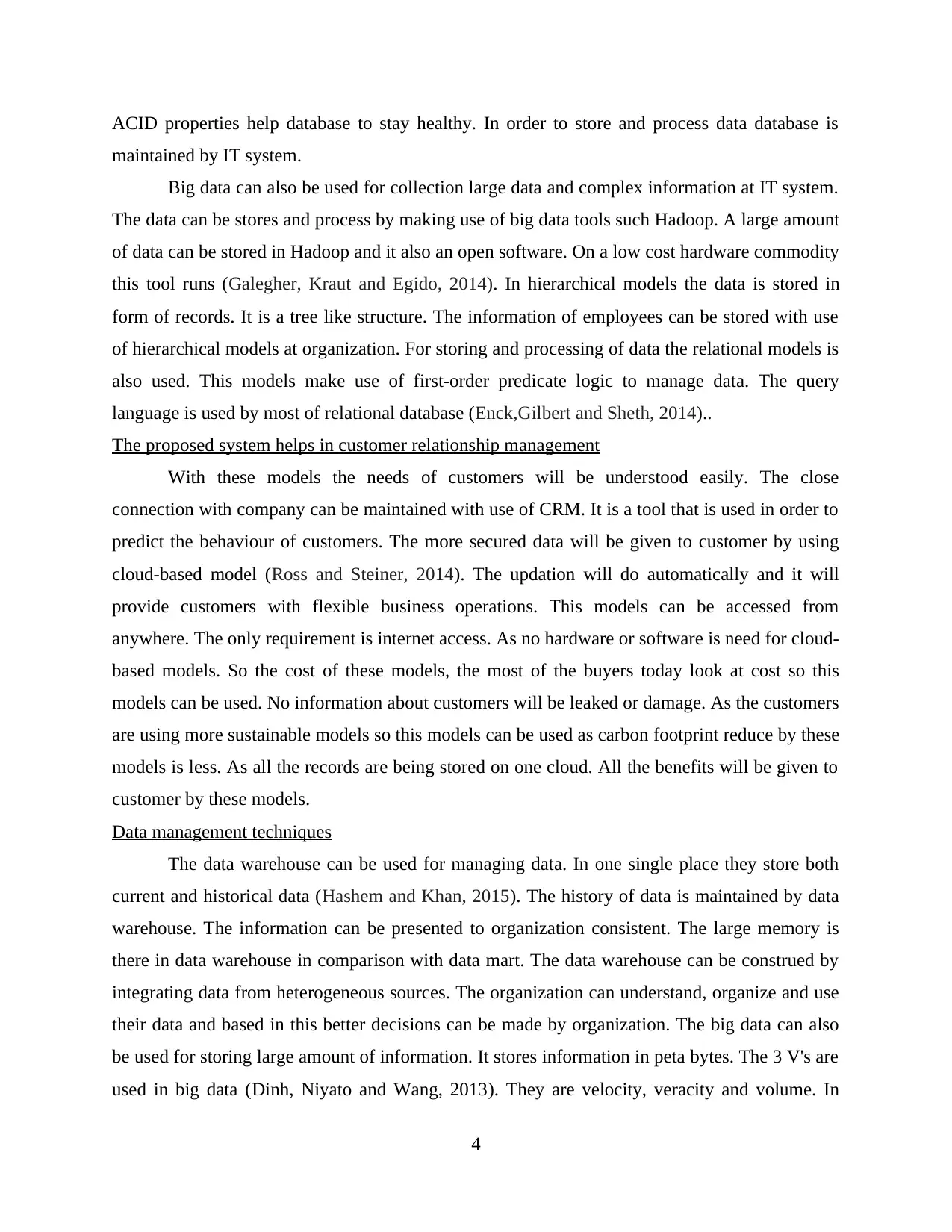
ACID properties help database to stay healthy. In order to store and process data database is
maintained by IT system.
Big data can also be used for collection large data and complex information at IT system.
The data can be stores and process by making use of big data tools such Hadoop. A large amount
of data can be stored in Hadoop and it also an open software. On a low cost hardware commodity
this tool runs (Galegher, Kraut and Egido, 2014). In hierarchical models the data is stored in
form of records. It is a tree like structure. The information of employees can be stored with use
of hierarchical models at organization. For storing and processing of data the relational models is
also used. This models make use of first-order predicate logic to manage data. The query
language is used by most of relational database (Enck,Gilbert and Sheth, 2014)..
The proposed system helps in customer relationship management
With these models the needs of customers will be understood easily. The close
connection with company can be maintained with use of CRM. It is a tool that is used in order to
predict the behaviour of customers. The more secured data will be given to customer by using
cloud-based model (Ross and Steiner, 2014). The updation will do automatically and it will
provide customers with flexible business operations. This models can be accessed from
anywhere. The only requirement is internet access. As no hardware or software is need for cloud-
based models. So the cost of these models, the most of the buyers today look at cost so this
models can be used. No information about customers will be leaked or damage. As the customers
are using more sustainable models so this models can be used as carbon footprint reduce by these
models is less. As all the records are being stored on one cloud. All the benefits will be given to
customer by these models.
Data management techniques
The data warehouse can be used for managing data. In one single place they store both
current and historical data (Hashem and Khan, 2015). The history of data is maintained by data
warehouse. The information can be presented to organization consistent. The large memory is
there in data warehouse in comparison with data mart. The data warehouse can be construed by
integrating data from heterogeneous sources. The organization can understand, organize and use
their data and based in this better decisions can be made by organization. The big data can also
be used for storing large amount of information. It stores information in peta bytes. The 3 V's are
used in big data (Dinh, Niyato and Wang, 2013). They are velocity, veracity and volume. In
4
maintained by IT system.
Big data can also be used for collection large data and complex information at IT system.
The data can be stores and process by making use of big data tools such Hadoop. A large amount
of data can be stored in Hadoop and it also an open software. On a low cost hardware commodity
this tool runs (Galegher, Kraut and Egido, 2014). In hierarchical models the data is stored in
form of records. It is a tree like structure. The information of employees can be stored with use
of hierarchical models at organization. For storing and processing of data the relational models is
also used. This models make use of first-order predicate logic to manage data. The query
language is used by most of relational database (Enck,Gilbert and Sheth, 2014)..
The proposed system helps in customer relationship management
With these models the needs of customers will be understood easily. The close
connection with company can be maintained with use of CRM. It is a tool that is used in order to
predict the behaviour of customers. The more secured data will be given to customer by using
cloud-based model (Ross and Steiner, 2014). The updation will do automatically and it will
provide customers with flexible business operations. This models can be accessed from
anywhere. The only requirement is internet access. As no hardware or software is need for cloud-
based models. So the cost of these models, the most of the buyers today look at cost so this
models can be used. No information about customers will be leaked or damage. As the customers
are using more sustainable models so this models can be used as carbon footprint reduce by these
models is less. As all the records are being stored on one cloud. All the benefits will be given to
customer by these models.
Data management techniques
The data warehouse can be used for managing data. In one single place they store both
current and historical data (Hashem and Khan, 2015). The history of data is maintained by data
warehouse. The information can be presented to organization consistent. The large memory is
there in data warehouse in comparison with data mart. The data warehouse can be construed by
integrating data from heterogeneous sources. The organization can understand, organize and use
their data and based in this better decisions can be made by organization. The big data can also
be used for storing large amount of information. It stores information in peta bytes. The 3 V's are
used in big data (Dinh, Niyato and Wang, 2013). They are velocity, veracity and volume. In
4
⊘ This is a preview!⊘
Do you want full access?
Subscribe today to unlock all pages.

Trusted by 1+ million students worldwide
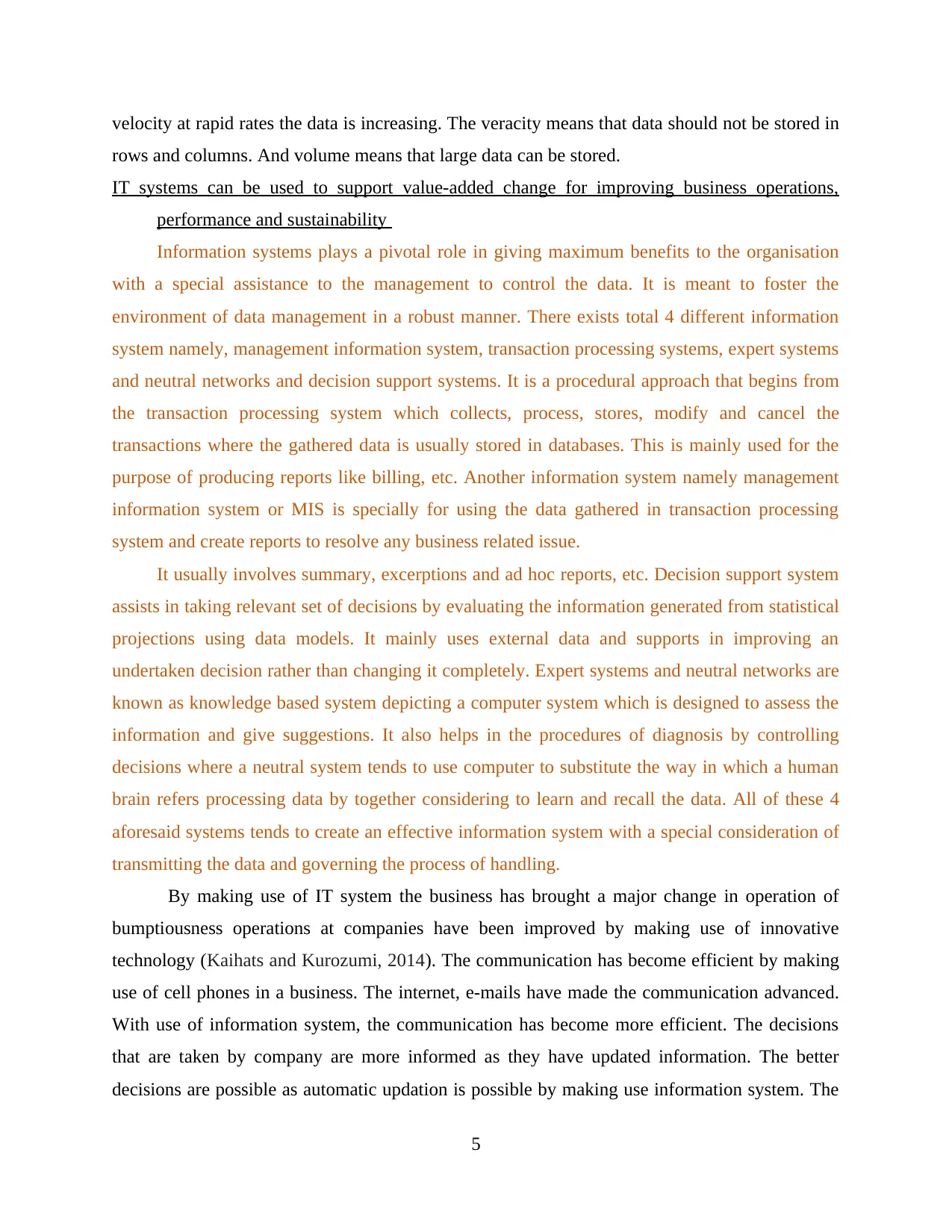
velocity at rapid rates the data is increasing. The veracity means that data should not be stored in
rows and columns. And volume means that large data can be stored.
IT systems can be used to support value-added change for improving business operations,
performance and sustainability
Information systems plays a pivotal role in giving maximum benefits to the organisation
with a special assistance to the management to control the data. It is meant to foster the
environment of data management in a robust manner. There exists total 4 different information
system namely, management information system, transaction processing systems, expert systems
and neutral networks and decision support systems. It is a procedural approach that begins from
the transaction processing system which collects, process, stores, modify and cancel the
transactions where the gathered data is usually stored in databases. This is mainly used for the
purpose of producing reports like billing, etc. Another information system namely management
information system or MIS is specially for using the data gathered in transaction processing
system and create reports to resolve any business related issue.
It usually involves summary, excerptions and ad hoc reports, etc. Decision support system
assists in taking relevant set of decisions by evaluating the information generated from statistical
projections using data models. It mainly uses external data and supports in improving an
undertaken decision rather than changing it completely. Expert systems and neutral networks are
known as knowledge based system depicting a computer system which is designed to assess the
information and give suggestions. It also helps in the procedures of diagnosis by controlling
decisions where a neutral system tends to use computer to substitute the way in which a human
brain refers processing data by together considering to learn and recall the data. All of these 4
aforesaid systems tends to create an effective information system with a special consideration of
transmitting the data and governing the process of handling.
By making use of IT system the business has brought a major change in operation of
bumptiousness operations at companies have been improved by making use of innovative
technology (Kaihats and Kurozumi, 2014). The communication has become efficient by making
use of cell phones in a business. The internet, e-mails have made the communication advanced.
With use of information system, the communication has become more efficient. The decisions
that are taken by company are more informed as they have updated information. The better
decisions are possible as automatic updation is possible by making use information system. The
5
rows and columns. And volume means that large data can be stored.
IT systems can be used to support value-added change for improving business operations,
performance and sustainability
Information systems plays a pivotal role in giving maximum benefits to the organisation
with a special assistance to the management to control the data. It is meant to foster the
environment of data management in a robust manner. There exists total 4 different information
system namely, management information system, transaction processing systems, expert systems
and neutral networks and decision support systems. It is a procedural approach that begins from
the transaction processing system which collects, process, stores, modify and cancel the
transactions where the gathered data is usually stored in databases. This is mainly used for the
purpose of producing reports like billing, etc. Another information system namely management
information system or MIS is specially for using the data gathered in transaction processing
system and create reports to resolve any business related issue.
It usually involves summary, excerptions and ad hoc reports, etc. Decision support system
assists in taking relevant set of decisions by evaluating the information generated from statistical
projections using data models. It mainly uses external data and supports in improving an
undertaken decision rather than changing it completely. Expert systems and neutral networks are
known as knowledge based system depicting a computer system which is designed to assess the
information and give suggestions. It also helps in the procedures of diagnosis by controlling
decisions where a neutral system tends to use computer to substitute the way in which a human
brain refers processing data by together considering to learn and recall the data. All of these 4
aforesaid systems tends to create an effective information system with a special consideration of
transmitting the data and governing the process of handling.
By making use of IT system the business has brought a major change in operation of
bumptiousness operations at companies have been improved by making use of innovative
technology (Kaihats and Kurozumi, 2014). The communication has become efficient by making
use of cell phones in a business. The internet, e-mails have made the communication advanced.
With use of information system, the communication has become more efficient. The decisions
that are taken by company are more informed as they have updated information. The better
decisions are possible as automatic updation is possible by making use information system. The
5
Paraphrase This Document
Need a fresh take? Get an instant paraphrase of this document with our AI Paraphraser
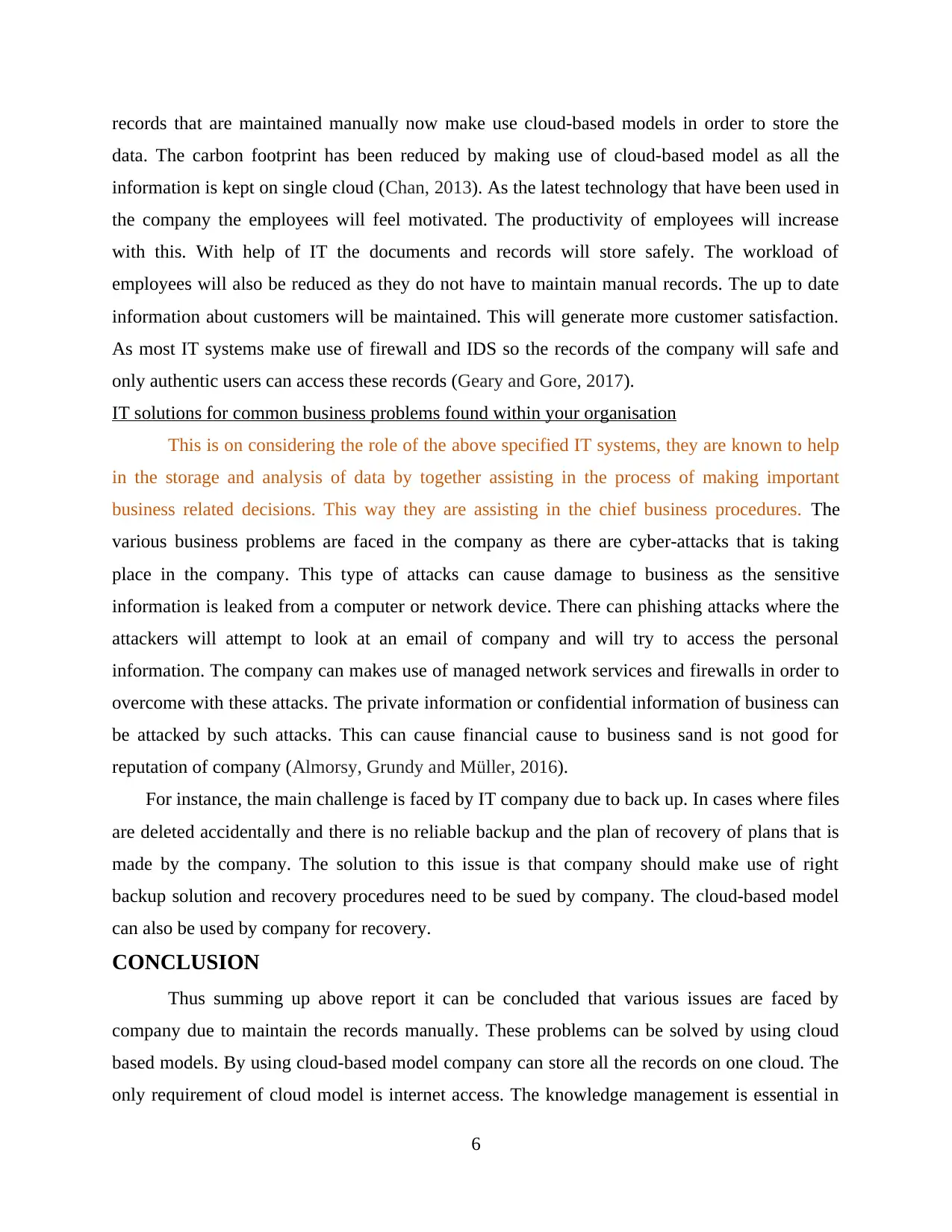
records that are maintained manually now make use cloud-based models in order to store the
data. The carbon footprint has been reduced by making use of cloud-based model as all the
information is kept on single cloud (Chan, 2013). As the latest technology that have been used in
the company the employees will feel motivated. The productivity of employees will increase
with this. With help of IT the documents and records will store safely. The workload of
employees will also be reduced as they do not have to maintain manual records. The up to date
information about customers will be maintained. This will generate more customer satisfaction.
As most IT systems make use of firewall and IDS so the records of the company will safe and
only authentic users can access these records (Geary and Gore, 2017).
IT solutions for common business problems found within your organisation
This is on considering the role of the above specified IT systems, they are known to help
in the storage and analysis of data by together assisting in the process of making important
business related decisions. This way they are assisting in the chief business procedures. The
various business problems are faced in the company as there are cyber-attacks that is taking
place in the company. This type of attacks can cause damage to business as the sensitive
information is leaked from a computer or network device. There can phishing attacks where the
attackers will attempt to look at an email of company and will try to access the personal
information. The company can makes use of managed network services and firewalls in order to
overcome with these attacks. The private information or confidential information of business can
be attacked by such attacks. This can cause financial cause to business sand is not good for
reputation of company (Almorsy, Grundy and Müller, 2016).
For instance, the main challenge is faced by IT company due to back up. In cases where files
are deleted accidentally and there is no reliable backup and the plan of recovery of plans that is
made by the company. The solution to this issue is that company should make use of right
backup solution and recovery procedures need to be sued by company. The cloud-based model
can also be used by company for recovery.
CONCLUSION
Thus summing up above report it can be concluded that various issues are faced by
company due to maintain the records manually. These problems can be solved by using cloud
based models. By using cloud-based model company can store all the records on one cloud. The
only requirement of cloud model is internet access. The knowledge management is essential in
6
data. The carbon footprint has been reduced by making use of cloud-based model as all the
information is kept on single cloud (Chan, 2013). As the latest technology that have been used in
the company the employees will feel motivated. The productivity of employees will increase
with this. With help of IT the documents and records will store safely. The workload of
employees will also be reduced as they do not have to maintain manual records. The up to date
information about customers will be maintained. This will generate more customer satisfaction.
As most IT systems make use of firewall and IDS so the records of the company will safe and
only authentic users can access these records (Geary and Gore, 2017).
IT solutions for common business problems found within your organisation
This is on considering the role of the above specified IT systems, they are known to help
in the storage and analysis of data by together assisting in the process of making important
business related decisions. This way they are assisting in the chief business procedures. The
various business problems are faced in the company as there are cyber-attacks that is taking
place in the company. This type of attacks can cause damage to business as the sensitive
information is leaked from a computer or network device. There can phishing attacks where the
attackers will attempt to look at an email of company and will try to access the personal
information. The company can makes use of managed network services and firewalls in order to
overcome with these attacks. The private information or confidential information of business can
be attacked by such attacks. This can cause financial cause to business sand is not good for
reputation of company (Almorsy, Grundy and Müller, 2016).
For instance, the main challenge is faced by IT company due to back up. In cases where files
are deleted accidentally and there is no reliable backup and the plan of recovery of plans that is
made by the company. The solution to this issue is that company should make use of right
backup solution and recovery procedures need to be sued by company. The cloud-based model
can also be used by company for recovery.
CONCLUSION
Thus summing up above report it can be concluded that various issues are faced by
company due to maintain the records manually. These problems can be solved by using cloud
based models. By using cloud-based model company can store all the records on one cloud. The
only requirement of cloud model is internet access. The knowledge management is essential in
6
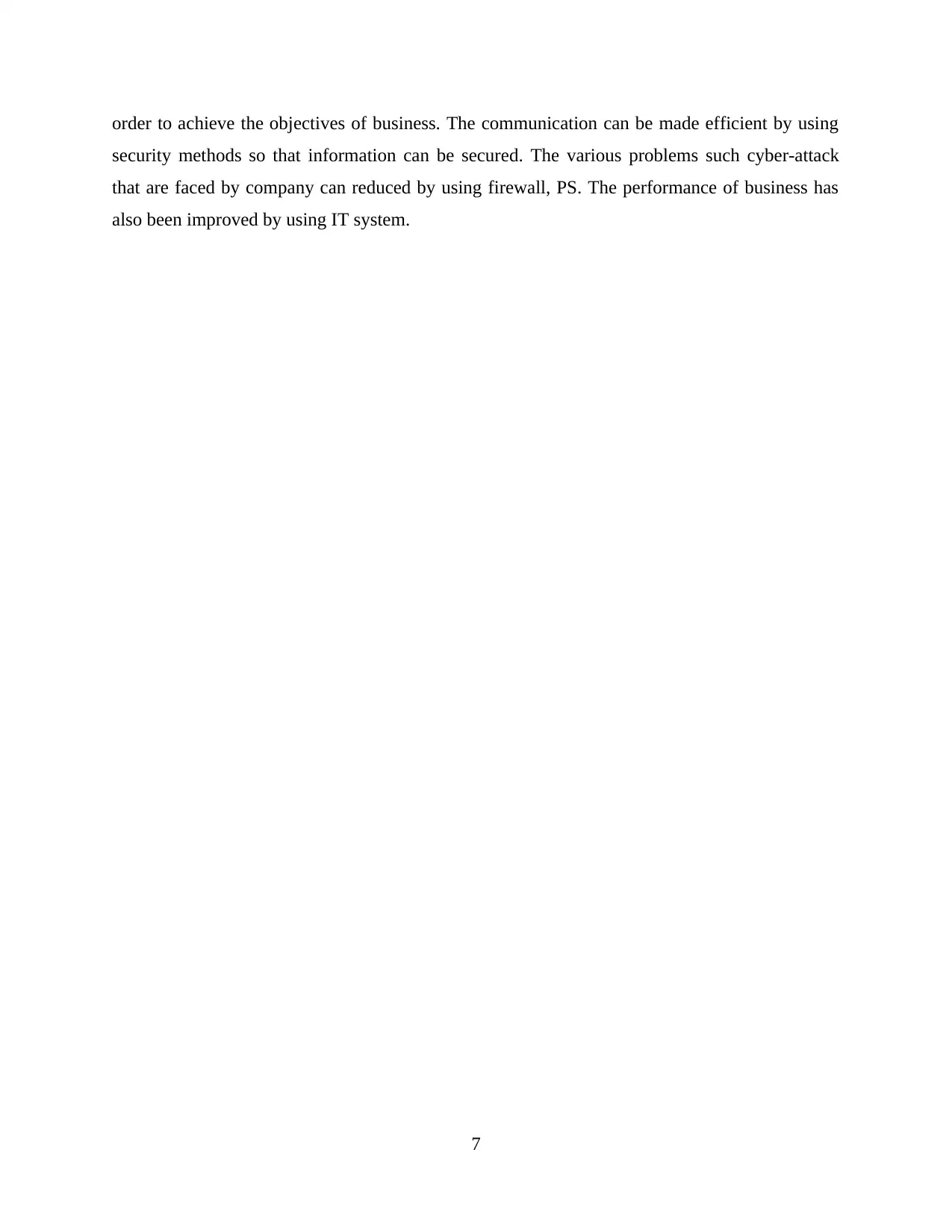
order to achieve the objectives of business. The communication can be made efficient by using
security methods so that information can be secured. The various problems such cyber-attack
that are faced by company can reduced by using firewall, PS. The performance of business has
also been improved by using IT system.
7
security methods so that information can be secured. The various problems such cyber-attack
that are faced by company can reduced by using firewall, PS. The performance of business has
also been improved by using IT system.
7
⊘ This is a preview!⊘
Do you want full access?
Subscribe today to unlock all pages.

Trusted by 1+ million students worldwide
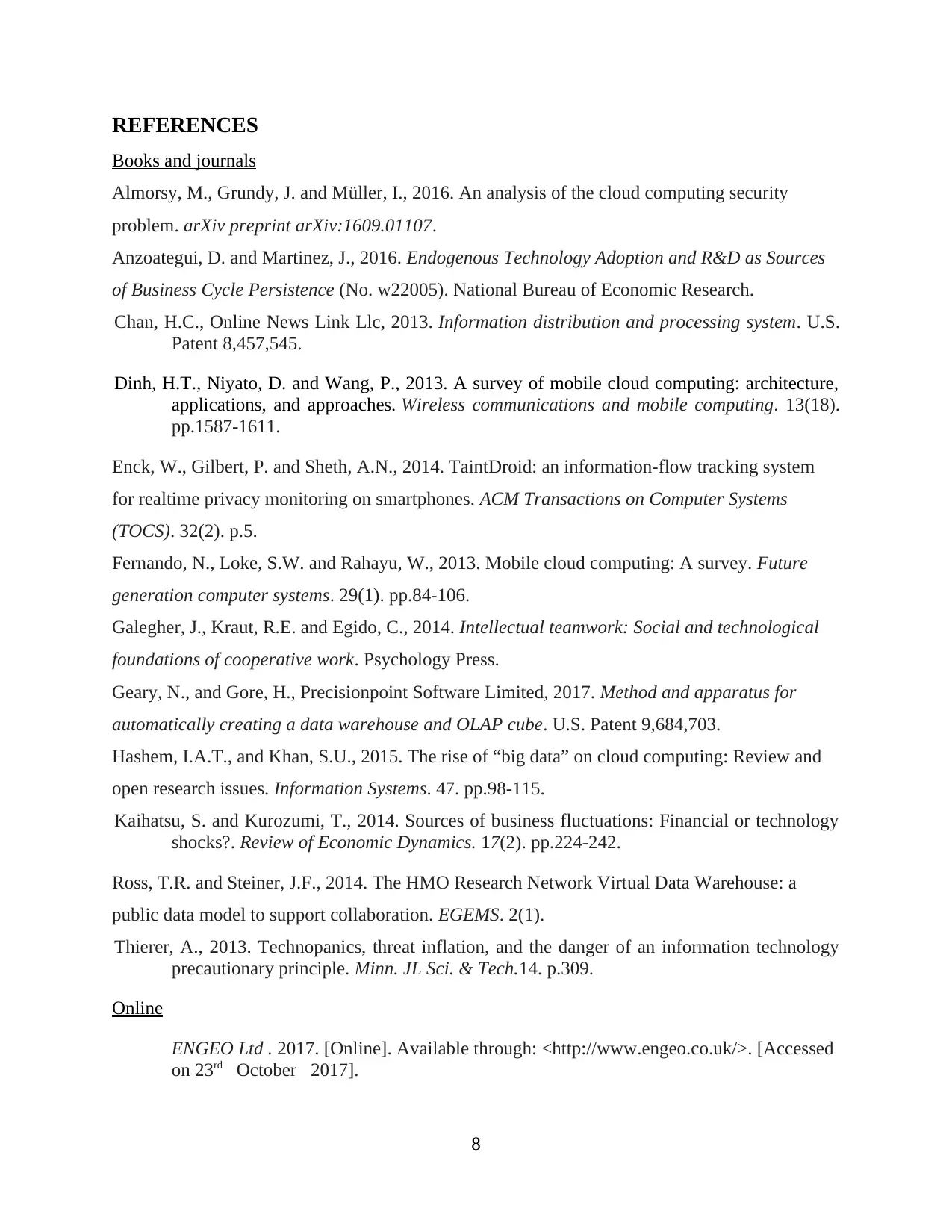
REFERENCES
Books and journals
Almorsy, M., Grundy, J. and Müller, I., 2016. An analysis of the cloud computing security
problem. arXiv preprint arXiv:1609.01107.
Anzoategui, D. and Martinez, J., 2016. Endogenous Technology Adoption and R&D as Sources
of Business Cycle Persistence (No. w22005). National Bureau of Economic Research.
Chan, H.C., Online News Link Llc, 2013. Information distribution and processing system. U.S.
Patent 8,457,545.
Dinh, H.T., Niyato, D. and Wang, P., 2013. A survey of mobile cloud computing: architecture,
applications, and approaches. Wireless communications and mobile computing. 13(18).
pp.1587-1611.
Enck, W., Gilbert, P. and Sheth, A.N., 2014. TaintDroid: an information-flow tracking system
for realtime privacy monitoring on smartphones. ACM Transactions on Computer Systems
(TOCS). 32(2). p.5.
Fernando, N., Loke, S.W. and Rahayu, W., 2013. Mobile cloud computing: A survey. Future
generation computer systems. 29(1). pp.84-106.
Galegher, J., Kraut, R.E. and Egido, C., 2014. Intellectual teamwork: Social and technological
foundations of cooperative work. Psychology Press.
Geary, N., and Gore, H., Precisionpoint Software Limited, 2017. Method and apparatus for
automatically creating a data warehouse and OLAP cube. U.S. Patent 9,684,703.
Hashem, I.A.T., and Khan, S.U., 2015. The rise of “big data” on cloud computing: Review and
open research issues. Information Systems. 47. pp.98-115.
Kaihatsu, S. and Kurozumi, T., 2014. Sources of business fluctuations: Financial or technology
shocks?. Review of Economic Dynamics. 17(2). pp.224-242.
Ross, T.R. and Steiner, J.F., 2014. The HMO Research Network Virtual Data Warehouse: a
public data model to support collaboration. EGEMS. 2(1).
Thierer, A., 2013. Technopanics, threat inflation, and the danger of an information technology
precautionary principle. Minn. JL Sci. & Tech.14. p.309.
Online
ENGEO Ltd . 2017. [Online]. Available through: <http://www.engeo.co.uk/>. [Accessed
on 23rd October 2017].
8
Books and journals
Almorsy, M., Grundy, J. and Müller, I., 2016. An analysis of the cloud computing security
problem. arXiv preprint arXiv:1609.01107.
Anzoategui, D. and Martinez, J., 2016. Endogenous Technology Adoption and R&D as Sources
of Business Cycle Persistence (No. w22005). National Bureau of Economic Research.
Chan, H.C., Online News Link Llc, 2013. Information distribution and processing system. U.S.
Patent 8,457,545.
Dinh, H.T., Niyato, D. and Wang, P., 2013. A survey of mobile cloud computing: architecture,
applications, and approaches. Wireless communications and mobile computing. 13(18).
pp.1587-1611.
Enck, W., Gilbert, P. and Sheth, A.N., 2014. TaintDroid: an information-flow tracking system
for realtime privacy monitoring on smartphones. ACM Transactions on Computer Systems
(TOCS). 32(2). p.5.
Fernando, N., Loke, S.W. and Rahayu, W., 2013. Mobile cloud computing: A survey. Future
generation computer systems. 29(1). pp.84-106.
Galegher, J., Kraut, R.E. and Egido, C., 2014. Intellectual teamwork: Social and technological
foundations of cooperative work. Psychology Press.
Geary, N., and Gore, H., Precisionpoint Software Limited, 2017. Method and apparatus for
automatically creating a data warehouse and OLAP cube. U.S. Patent 9,684,703.
Hashem, I.A.T., and Khan, S.U., 2015. The rise of “big data” on cloud computing: Review and
open research issues. Information Systems. 47. pp.98-115.
Kaihatsu, S. and Kurozumi, T., 2014. Sources of business fluctuations: Financial or technology
shocks?. Review of Economic Dynamics. 17(2). pp.224-242.
Ross, T.R. and Steiner, J.F., 2014. The HMO Research Network Virtual Data Warehouse: a
public data model to support collaboration. EGEMS. 2(1).
Thierer, A., 2013. Technopanics, threat inflation, and the danger of an information technology
precautionary principle. Minn. JL Sci. & Tech.14. p.309.
Online
ENGEO Ltd . 2017. [Online]. Available through: <http://www.engeo.co.uk/>. [Accessed
on 23rd October 2017].
8
1 out of 10
Related Documents
Your All-in-One AI-Powered Toolkit for Academic Success.
+13062052269
info@desklib.com
Available 24*7 on WhatsApp / Email
![[object Object]](/_next/static/media/star-bottom.7253800d.svg)
Unlock your academic potential
Copyright © 2020–2025 A2Z Services. All Rights Reserved. Developed and managed by ZUCOL.





